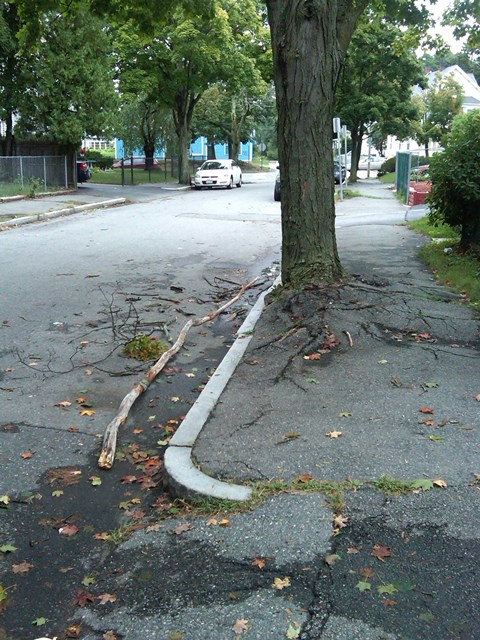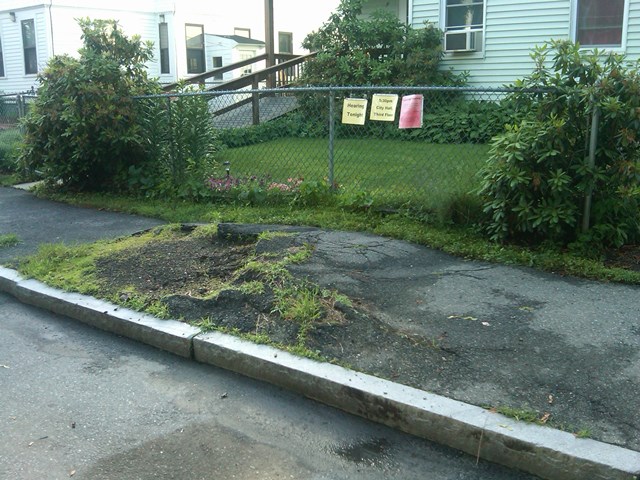City government is an interesting machine. And by interesting, I mean, hard to figure out. Here’s the photo- and video-tale of how I got a new sidewalk in Worcester, MA. It took three and a half years. If you have something similar in need of doing, you might learn from my experience.
It began in 2010. One of the maple trees for which the street was named was dying. It would loft large pieces of itself into the air every time the wind blew. Some of them were large enough to hurt someone, or to crush a car like in an All State commercial. Here are two of the evidence shots I submitted to my city councilor, who at the time was Bill Eddy. (These were taken on different days.)


The City of Worcester owns all the trees in the sidewalk. When I asked a city representative if I could pay for my own arborist to come and prune the dead out, she told me that if I so much as rubbed a piece of bark off it, they would be lawfully entitled to fine me for destruction of the entire tree according to the circumference of the trunk. It was something prohibitive like $50 per inch of circumference.
I asked Bill Eddy if the city could assemble a list of “certified arborists” so that I could hire one and prune the tree legally. I offered this to help with the tremendous backlog of arbor work that had resulted from the asian long-horned beetle disaster.
The official work order was entered May 24, 2010. What you see below is real. I edited it only to remove my address, phone number, and email address. Look at how it ends, where it says “CLOSED”:

The only reasonable interpretation of this otherwise senseless remark, “no city tree at this location,” was that Councilor Eddy had done some back room dealings and given me a free hand to prune the tree myself. The city had disowned it. Perfect! I started getting quotes from arborists to prune it. This was September 8, 2010.
The night of September 21 I drove home thinking about which arborist to hire. I pulled onto my street and lo! the tree was gone. Nothing remained but the stump and the upheaved sidewalk.
I called Billy Eddy to ask whether it would have been better just to prune the dead. I also asked about the stump and the sidewalk. I couldn’t get through to him, so I asked these questions in a voicemail. I would not hear from him again for two years.
On November 27, 2011, one year after the removal, the stump was ground down to a dusty pile. Now all that remained was the badly damaged sidewalk.
I waited. And waited. I called the city and asked what would be done about the sidewalk. Twice I was told someone would be out to repair it. The third time I was told, “Oh, that requires a petition!”
Shortly afterward, on March 20, 2013, I went to some lengths to post a sign out front inviting neighbors to sign a petition to City Council. I collected seven signatures with this passive device. I wanted to leave it out for two weeks. Then one night the petition blew away, carrying all of its signatures with it, never to be seen again.
I submitted the petition anyway on March 29, 2013, indicating all that had happened. It included the following imagery, juxtaposing the awful crater with my otherwise scenic front yard:

You can see how I encouraged neighborhood support by tying the petition text to my fence. When it was finally scheduled, I also tied up notice of the hearing, which was to be on June 19, 2013.
At the hearing I brought one neighbor, also a member of the Worcester Property Owners Association, and a prepared speech. I was one of the last petitions to be heard, after several hours of very tedious repetition of questions about how street paving was to be assessed. When I finally had my chance at the podium, I asked if I should read my speech or if there was no objection to fixing the sidewalk. Councilor Toomey apologized and said the sidewalk should have been fixed as part of the tree removal, and that it would be done before winter. No speech was required. Everyone breathed a sigh of relief.
Privately I was advised by someone else to notify Bill Eddy about this successful hearing, otherwise the process might stall. So I notified him via email on July 10. He said it couldn’t possibly be done before next summer. I explained what had been said at the hearing and he said he’d look into it. On October 18, without any other notice, they came to dig out the stump. They posted the no-parking signs around 8a. I protested that it wasn’t fair to give no notice, and that I’d have to interrupt the neighbor’s morning routines to get them to move their cars. The man said, “If the sign is up, I can tow.”
I recorded some of the work:
On October 29, after leaving the “no parking” signs up for a week, they came and paved over the smoothed bed at 7 in the morning.
That’s 1,254 days and many, many follow-ups since the request was first made.

Suggestions for Improvement
I think these small changes would make things a little bit better here in Worcester:
- Recognize certain independent contractors as “city approved” and allow property owners with the means to hire them to work on city projects, especially trees, but perhaps also including sidewalks.
- Notify customers when work orders have been closed.
- Streamline the petition process by giving 30 minute hearing windows and cutting people off if they take more than so many minutes to explain their case.
- Treat “no parking” signs with more seriousness. Put them up the day before, write the word “tomorrow” on them, and take them down when work is going to be paused the next day, or week.
There certainly must be big changes required, as well. I hear the average time to fix a sidewalk isn’t as long as mine, but it’s still two years. If the city were a factory, I’d say their sales department needs to follow up better on orders, and I’d say their operations teams have too much going on in parallel. I’d also look into whether “squeaky wheels” weren’t constantly cutting in line. Probably city management could learn a lot by comparing Worcester’s performance to that of other cities.
What do you think? Leave a comment below!